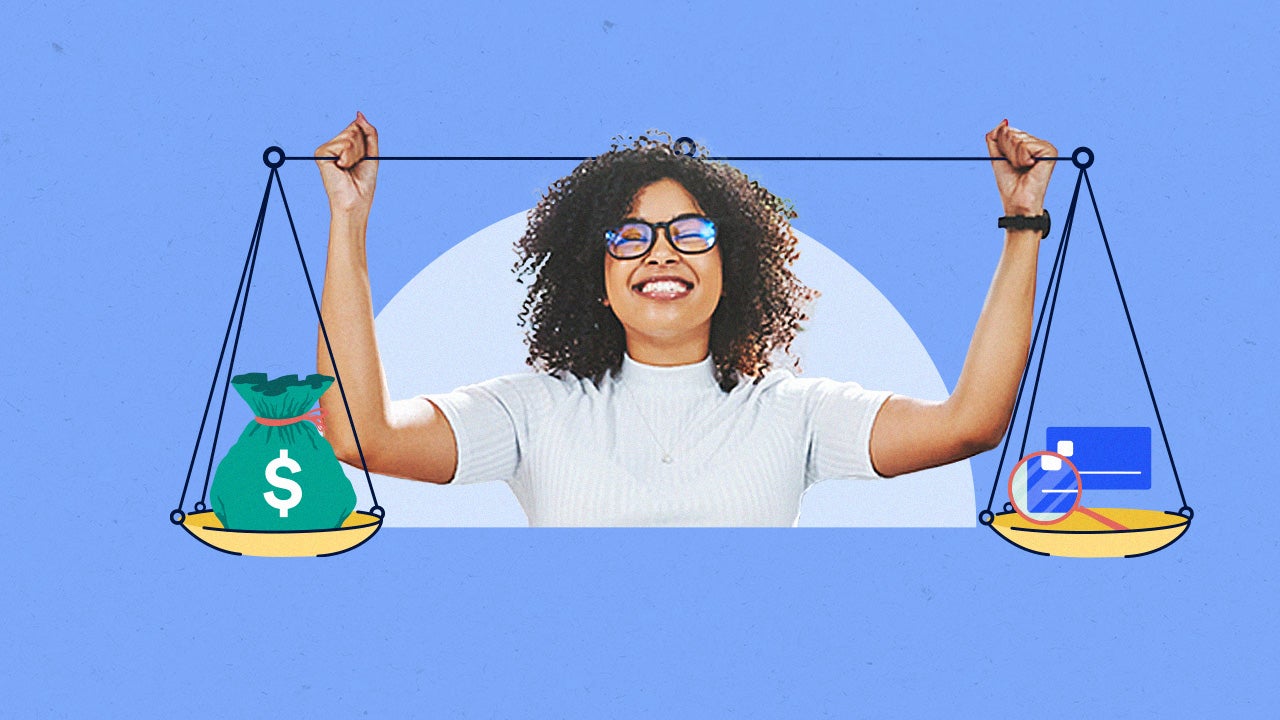Want to get out of credit card debt? Here’s how this couple paid off $27,000 in 18 months

This page was originally published in mid-2021 and still contains relevant interview quotes from that time. The rest of the article has since been updated.
Key takeaways
- Tana Williams and her husband found themselves in nearly $27,000 in debt after a series of emergency expenses came up, coupled with years of overspending.
- To get out of debt, they came up with a new budget, started taking on side hustles to earn extra income and found a debt management method that worked for them.
- Debt management is different for everyone, but learning about the tools and methods that others have used to escape debt can help you find something that works for your situation.
If you’re in more credit card debt than you can handle, you might feel like you’re out of options. But, there is a way out. Many people are able to successfully pay off their credit card debts in full, whether they consolidate debts onto balance transfer credit cards, create a budget that allows them to prioritize debt repayment or use popular debt payoff techniques, like the snowball method or the avalanche method.
Tana Williams, a digital marketer who writes about her financial journey on her blog, Debt Free Forties, worked with her husband to pay off $26,619 of debt in just 18 months — $3,251 of which was credit card debt. The two of them used a combination of budgeting, side-hustling, expense-cutting and payment strategizing to get their credit card, car loan and student loan debt down to zero. But, it took them a few tries before they were able to successfully commit to the debt repayment process.
“Consistency is a personal struggle for me on all levels — so even though we were driven and I had the skill set to make decent money with a side gig, we still found ourselves straying off the debt repayment path,” Williams said. “We’d tackle a massive debt and then wander off and start a costly house project. We were doomed to repeat the cycle several times until it finally clicked for good in January 2017.”
How did Williams and her husband get into five figures of debt — and how did they get out of it? We asked Williams to share her story and offer advice for anyone else who might be in a similar situation.
How the Williams family got into debt
Credit card debt can happen to anyone — so don’t feel bad if it happens to you. For Williams and her husband, the descent into debt was slow.
My husband and I acquired our debt like so many others. It started with the classic combo of credit cards in college and student loans.— Tana Williams, creator of Debt Free Forties
After taking on a car loan, a mortgage and dealing with the hospital bills associated with the birth of two children, Williams and her husband fell into the all-too-common habit of putting more day-to-day expenses on credit than they could afford to pay off — and this habit continued, month after month.
“While we didn’t purchase anything extravagant or outrageous, we still spent more than we earned every month, leading us into a nice pile of debt,” said Williams.
In addition to buying more than they could afford, Williams and her husband found themselves faced with a few emergency expenses that quickly added to their credit card balances. “Once,” recalled Williams, “we had storm damage to our roof when my husband was laid off for a couple of months and had to use a credit card to cover the deductible. We also used a credit card to pay off a hefty tax bill, which, in hindsight, was a hot mess — especially after they tacked on a significant credit card processing fee.”
So, why did the Williams family prioritize discretionary spending over important financial goals like building an emergency fund? Like many people, they wanted to live a life that was slightly beyond their means. “I think we both just assumed that was the quality of life our parents lived,” Williams said, “so that’s what we expected our lives to be like as well.”
The 5 steps this couple used to pay down their debt
1. Create a budget — and then create a plan
“Budgeting was a big part of our debt repayment story,” Williams explained. After she and her husband made a home budget and began tracking their spending, they were able to see where their money was really going every month. Then, they made a plan that prioritized debt repayment over other types of discretionary expenses.
Once we started budgeting — and not just recording what we spent after the fact — we could see where our money leaks were. We got rid of cable, switched to pay-as-you-go mobile plans and trimmed our entertainment budget massively. We asked for discounts from every place we could, including our daycare services, and began to shop at discount grocery stores.— Tana Williams, creator of Debt Free Forties
2. Use 0% intro APR cards to save money on interest charges
Many people use zero-interest promotional offers to save money on credit card interest charges — but even the best 0 percent intro APR cards only work if you pay off your balance in full before the promotional interest rate ends.
We made sure that any debt at 0 percent for a set amount of time was paid off the month before that final payment was due. If we owed $2,000 on a 0 percent credit card, and we had seven months before the interest hit, we’d aim to pay it off in six months and pay $333.33 a month.— Tana Williams, creator of Debt Free Forties
Once Williams and her husband had paid off all of their 0 percent intro APR cards, they avoided opening any new zero-interest promotional accounts, including balance transfer credit cards.
“We knew our weak points, and getting new cards at 0 percent interest seemed too easy to backslide,” noted Williams.
While Williams might have been able to save money on interest charges by taking out new credit cards with 0 percent intro APR offers, she and her husband decided to focus on paying off their existing credit accounts first.
3. Use a tried-and-true debt repayment strategy
We used a combination of tactics to knock out our debt. I picked up freelance web development and started a blog, and my husband worked extra hours when he could. We also sold things around the house, moved to a lower cost of living area and used the snowball method.— Tana Williams, creator of Debt Free Forties
The snowball method is a tried-and-true debt repayment method popularized by financial expert Dave Ramsey. When you use the snowball method to pay off debt, you pay off your smallest debt first while making minimum payments on all your other credit accounts. Then, you use the money you had previously budgeted toward your smallest debt and add it to the minimum payment for your next-smallest debt.
As you pay off each debt in turn, the amount of money you can afford to put toward your next debt snowballs — and as each debt payment becomes larger, you start to pay off your debts more quickly.
A common alternative is the avalanche method, which requires that you focus on paying off the debt with the highest interest rate while making minimum payments on all the others.
4. Avoid creating new debt by making it hard to spend on credit
One way Williams avoided taking on new debt as she paid off her credit cards was by making it more difficult to make purchases on credit.
We did things like locking our credit cards away. We also removed our credit card information from Amazon and other websites we frequented to make it harder to accrue more debt mindlessly.— Tana Williams, creator of Debt Free Forties
Now that Williams and her husband are free of credit card debt, they’ve gone back to using credit on a regular basis — but they only make purchases they can afford to pay off in full. Williams also times her credit card payments to keep her credit utilization low and take advantage of her credit card’s interest-saving grace period.
“We do have a couple of credit cards, and we charge things on them monthly,” Williams said. “However, we pay them off every two weeks to avoid any interest or fees. It’s easier to keep an eye on them and make sure that they’re not creeping up and getting out of control again because you’re reviewing them more regularly.”
5. Be consistent — and find a way to stay motivated
What advice does Williams have for people who are looking to pay off their own credit card debt?
“Be consistent!” says Williams. “While your debt payoff story will have its ups and downs, what makes it work is you continuing to plow through those setbacks…It isn’t the rush out the gate that’ll get you to the finish; it’s consistently doing one or two steps every day, which adds up over time to get you to the end.”
Since debt repayment is often more of a marathon than a sprint, it’s a good idea to find a way to stay motivated — even during setbacks. Williams suggests connecting with other people who are also trying to get out of credit card debt, and sharing your struggles and successes as you work toward your goal.
Find support and motivation to help you keep going, whether it’s books, blogs, podcasts, friends or a Facebook group. Being surrounded by like-minded folks with similar goals makes a world of difference!— Tana Williams, creator of Debt Free Forties
The bottom line
People fall into debt in a variety of ways. Sometimes, it happens quickly, like after taking on a large unexpected purchase, while other times, it happens much slower, like in the case of the Williams family and their lifestyle creep. But no matter how you get into debt, you can find a way forward with the right tools.
In the case of the Williams family, they made an aggressive budget with numerous lifestyle changes while also taking on more work to generate additional income. They also used 0 percent intro APR credit cards to avoid paying interest on some of their debt, while at the same time, they made it harder to actually use their credit cards.
All of their planning paid off when they finally became debt-free in 18 months. While your debt payoff journey will likely look different than theirs, that doesn’t mean the same result is out of reach. If you’re not sure where to start when it comes to paying down your debt, consider working with a certified credit counselor on a debt management plan.
You may also like

How to settle credit card debt





